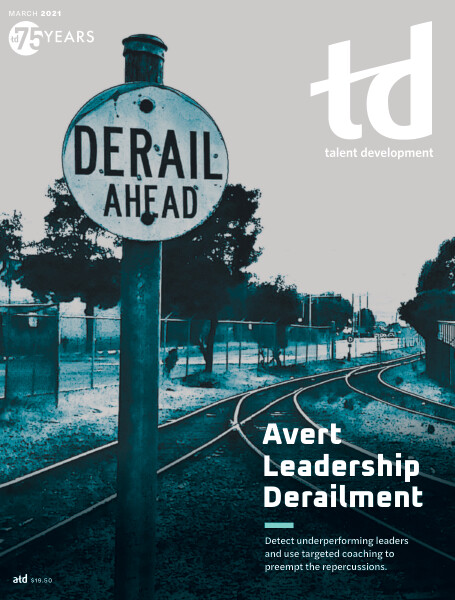TD Magazine Article
Maximize Minimal Monies
Economic uncertainty means prioritizing TD spending and identifying the learning solutions that will have the biggest impact on the business.
Mon Mar 01 2021

Jobs, businesses, commerce, and budgets are in limbo. As a result, many companies are engaging in cost-cutting initiatives, which has a downstream impact on learning budgets, requiring talent development functions to do more with less. It is ironic that, in times of crisis, companies trim budgets just when they should be increasing them to support employees and leaders as they cope and deal with the challenges ahead. Growing people's skills will ensure that they are equipped to navigate the unforeseen business disruption.
As TD professionals, we have a challenging job—whether going through a crisis, as many of us are today, or planning for the company's future growth in a normal year. We must support employees and the company as much as possible while being thoughtful and judicious in how we use our precious budget. The questions are many, though:
How do we adequately provide learning support when we have fewer resources and money?
How do we create and execute a learning strategy that supports the business?
How do we include learning solutions that have the biggest impact on the business?
Should we buy learning solutions or build them—or both?
Fortunately, while all that seems daunting, it does not have to be if we follow some simple steps.
Know the business
We are most valuable to our employers when we help address a complex business problem via a learning solution. But solving this problem requires a good understanding of the business.
The first step is to look at what is going on in the business. Why does the business problem exist? What is the root cause? What would make the business more successful? What are the critical roles in the business?
Several years ago, a technology company was experiencing a scarcity of sales talent to market its technology solution. It typically hired experienced sales reps, which was fine until the industry became so competitive that there was a shortage in the talent pool. To address the problem, the company needed to hire inexperienced college graduates and train them to be great sales executives in the high-tech industry. I was engaged to design a strategy that would quickly get these new graduates up to speed so they could fill the talent gap.
The business context will help you isolate the problem.
Identify the problem
Evaluate the problem fully before trying to create a solution. Otherwise, you may end up solving the wrong problem.
For example, if the need is improving employee engagement, examine the causes of the low engagement. It may not have anything to do with the workers themselves; it may be due to a bigger and more concerning problem. Perhaps it is because managers are not well trained, staff don't have clear processes documented for their jobs, or many employees believe their job is just a job and not something that is helping them build a career.
Whatever the cause, it will provide you clues as to how to address the problem. Say the primary cause is managers are not well trained. That means your next task is to identify what the managers are not doing well versus what they should be doing. Evaluate what development they have had, if any, and whether it aligns with the problems. Maybe the training program is just missing some elements or needs substantive improvements.
Isolating the problem is a bit like triage typically found in healthcare—you are checking the vitals and looking for symptoms of what is wrong and needs to be fixed. When you take this consulting approach, you will be amazed by what you uncover about the real problem.
Address the problem
Now that you've identified the problem, it is time to address it by taking a deeper dive into the existing skills gaps. For the critical roles that you are reviewing, what must individuals need to be able to do to be successful? Notice the word do rather than know.
Knowing isn't necessarily being able to use the knowledge. To achieve greatest impact, a learning strategy or solution must focus on skills and capabilities in addition to competencies. Is there a role model, a great model for success whom you could use to identify the necessary skills? If there are multiple skills needed, which are the most important?
Regarding the sales talent problem at the tech company mentioned earlier, the most important skill was the ability for salespeople to use each step of the company's sales process the way it was designed to be used. Why was that so important? Because the sales executives who were the least successful did not properly follow the sales process. They took shortcuts. However, the best role model sales executives, those who generated the most revenue and had high customer satisfaction, were diligent in following every step of the sales process.
With a list of skills and capabilities in hand, it may seem overwhelming for you to create a comprehensive learning strategy. However, it needn't be if you focus on the critical skills necessary to help the individual be successful in doing their current job or preparing for the next job.
I've seen TD professionals put everything but the kitchen sink in their learning strategy. Not only is that unnecessary, but it can result in an overly complex strategy that is difficult to modify. Keep your strategy as simple as possible. Keep the focus on what employees must do to be successful, and simplify the design with a logical flow by aligning it to a meaningful framework.
For sales training, use the sales process as a framework. For management development, use the day-to-day management tasks. For leadership development, focus on self-leadership, team leadership, and organization leadership. And for onboarding, use the company values as a framework.
Whatever the situation, there are likely various frameworks that you can use as a logical flow to ensure that learning is focused on the most important skills and capabilities needed to solve the problem while contributing to the individual's success.
Determine the solution
This step is when the budget game can be won or lost. It's also when many of us fall prey to the costly shiny objects presented to us as potential solutions. There is a plethora of learning consultants, programs, courses, and solutions on the market today—all of which describe themselves as being able to solve your most pressing learning problems. But will they?
Resolving the business problem with limited resources can be tricky. You will need to decide when it would be more cost effective to design and build a program versus spending funds outsourcing to a consultant or buying a turnkey solution. Don't fall victim to thinking that the more expensive a solution, the better it is. It isn't. Weigh costs, benefits, and impact.
The best learning strategies include a variety of learning solutions—some licensed or purchased and some built internally. One of the best strategies in determining whether to buy or build is not in looking at the price but rather in evaluating whether the solution is something that your company can use turnkey or requires the inclusion of proprietary information.
Take, for example, sales training programs, which are widely available. Do they require that you use them as is, or can your team customize them to align to your company's specific sales process? Do the management development programs on the market include your managers' daily tasks? If not, can you use one of the programs for part of your solution and then create some proprietary content?
Also, decide whether your learning solution will be mandatory for employees. Mandatory is usually used for regulatory and compliance training, job-specific functional skills, or gates for promotions.
Watch the budget
Budgeting wisely requires you to be innovative and creative in how you allocate your money. When designing strategies, I earmark most of my budget between licenses, third-party custom development firms, technology, and generic learning content. I do not outsource strategy design, because I found out the hard way that I could not afford to implement the strategy they created.
One cost-cutting strategy I swear by is to purchase inexpensive, reproducible, customizable training libraries, such as HRDQ or Corporate Training Materials. Seek out vendors that produce high-quality, professional-looking courses that include facilitator guides, participant guides, slides, and marketing collateral. In addition, you'll want a vendor that allows customization to, for example, include your corporate branding and remove sections you don't want to use or change sections that you need to modify. This rapid development strategy enables you to deliver content quickly while saving precious budget for external courses.
Another low-cost tactic is to leverage a learning experience platform, such as Degreed or EdCast, which aggregates content from a variety of sources and customizes learning journeys or pathways to support your learning solutions. Such platforms provide flexibility and are user friendly.
Learning experience platforms enable you and your team to save money and address learning needs quickly by curating content rather than creating it. Another advantage is the ability to modify frequently to align with ever-changing business needs and ensure continual relevance. That is especially advantageous because custom-developed courses often have a short shelf life and quickly become obsolete.
Another area that can eat up precious learning budget is facilitation. Are you hiring external facilitators when perhaps an internal leader could be a guest facilitator? Leaders-as-teachers strategies save money and also can provide platforms for leaders to gain visibility and demonstrate their competence to audiences broader than just their team. And people learn a lot when they teach. Imagine building an internal leadership development solution where leaders are consistently teaching other leaders.
Remember your team
While designing and developing your learning strategies, it is easy to forget about developing your team. I reserve part of my budget to enable my team members to grow their skills in a variety of areas—learning design and curriculum development, performance consulting, presentation and facilitation skills, and certifications to deliver various programs and assessments. That is money well spent because it keeps them learning, growing, and engaged. In addition, once they have increased their skills and capabilities, team members can take on more of the work you would have previously outsourced.
Do more with less
Several times and at multiple companies, I have used all the strategies mentioned, enabling me to create several successful learning strategies. Case in point: Regarding the sales executive training example, the learning strategy and program I designed ended up being a four-month innovative program that included instructor-led classroom training, an online learning portal, peer coaching, and on-the-job learning activities. With the exception of the online learning portal content, one of my team members and I created the overall learning strategy, designed the individual program elements, developed the curriculum, and facilitated the instructor-led training—thereby minimizing spending.
The pilot program included 20 learners, out of whom 19 became successful sales executives in the company, delivering on the strategy's promise. And since that initial program, many of the participants are now successful sales leaders and vice presidents with prestigious technology and consulting firms.
Be thoughtful with your budget by planning how you can support the business, employees, and your team while leveraging the situation to be innovative and creative.

